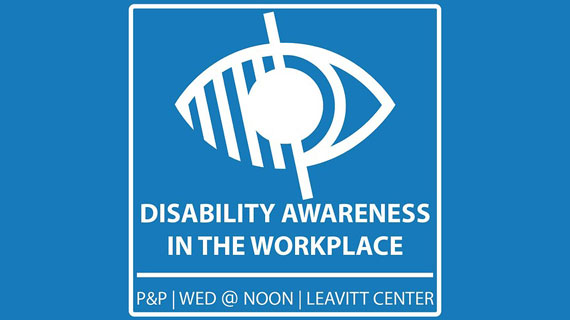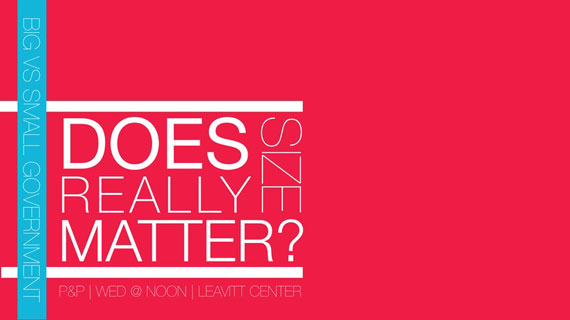Pizza & Politics- Disability Awareness
Posted: December 04, 2017 | Author: Cami Mathews | Read Time: 5 minutes
 The Michael O. Leavitt Center for Politics and Public Service hosts Pizza & Politics every Wednesday at noon to discuss a current political topic. Leavitt Center student employees research the topic and moderate the conversation. These discussions expose students to a variety of important issues and encourages them to share their own perspectives while learning all sides of an issue. Free pizza is provided for all who attend.
The Michael O. Leavitt Center for Politics and Public Service hosts Pizza & Politics every Wednesday at noon to discuss a current political topic. Leavitt Center student employees research the topic and moderate the conversation. These discussions expose students to a variety of important issues and encourages them to share their own perspectives while learning all sides of an issue. Free pizza is provided for all who attend.
Working with Southern Utah University’s Disability Office, the topic of discussion for Pizza & Politics was Disability Awareness in the Workplace. The Disability Office hosted Disability Awareness Week on campus, giving the Leavitt Center a chance to support while diving into a political discussion.
The event was moderated by Kenten Pope, a graduate student in the Masters of Professional Communication program, and Taylor Cella, a junior Information Systems major.
To start the conversation, students were given disability employment rates. Only 34% of working-age people with disabilities were employed on average in 2014, compared to over 75% of people without disabilities. Employed people with disabilities are underrepresented in management and professional/technical jobs, and over represented in service, production, and transportation jobs.
Many people with disabilities are paid subminimum wages. On average, these wages are $2 an hour, but can be lower. Companies can apply for a certificate to pay subminimum wages to workers with disabilities. Subminimum wages are designed to prevent the loss of employment opportunities for those with disabilities. They apply to those whose disabilities affect productive capacity, such as blindness, mental illness, developmental disabilities, cerebral palsy, alcoholism, and drug addiction.
Should businesses be able to legally pay workers with disabilities a subminimum wage?
The audience supported each other in the opinion that subminimum wage is a way to exploit workers with disabilities. People felt that if a company could not afford to pay a worker minimum wage, they should not be in business. Students did not think that subminimum wages save jobs for workers with disabilities, they merely save the company money while treating people unfairly.
Which is better: sheltered workshops or integrated employment?
To give background information, sheltered workshops are supervised workspaces for people with disabilities. Work is generally repetitive and commonly involves packaging and assembling products, such as making jewelry or sorting mail. Sheltered workshops were created to work as a “training program” to prepare those with disabilities to enter the workforce. They are also seen as opportunities for people with disabilities to work with their peers.
Integrated employment merges people with disabilities into a typical workplace setting where most employees do not have disabilities. The workers are paid minimum wage and are paid directly by the employer.
The audience was split in their opinions on the two options. Those in favor of sheltered workshops felt that it gave the people with disabilities a chance to work with their peers and be supervised in a way they are needed. An audience member brought up a story where a person with disabilities was working at Wal-Mart, but did not know they were allowed to take a break during the day. The audience member felt that if they had been in a sheltered workshop, they would not have encountered that problem because they would have been supervised differently.
Those who supported integrated employment suggested that people with disabilities should be able to interact and be friends with those who do not have disabilities. They felt that sheltered workshops give monotonous jobs to people with disabilities, while integrated employment allowed for more freedom and flexibility.
Should every business be required to be ADA compliant, regardless of size?
Title 1 of the Americans with Disabilities Act (ADA), helps people with disabilities access the same employment opportunities and benefits available to people without disabilities. However, this only applies to employers with 15 or more employees.
To start, most people in the audience disapprove of government mandates, so few felt that any of this should be mandated. However, those that did think companies should be required to be ADA compliant, thought if you could not make your business accessible to all, should not have a business.
Some suggested that smaller companies, who may not be able to afford to be ADA compliant, receive money to help them with the process. This would help alleviate stress on companies that want to be accessible, but do not generate enough income to make changes.
Should SUU go out of their way to make ADA accommodations?
SUU has an ADA transition plan that is implemented into new projects on campus. For example, the new business building will be completely ADA accessible based off of the plan. However, completed buildings or areas on campus that are not being renovated, will not have any changes made until there is a larger initiative.
Changes that SUU has made over the past few years include wheelchair ramps, wider doorways, updates to restrooms, audio crosswalks, wheelchair accessible sidewalks, and more parking stalls.
In the audience was a student who works with SUU’s facilities management team, as well as MIke Humes, director of safety and risk management. Comments clarified that although the school would like to make changes to past mistakes, there is not enough money to make every corner of campus accessible to all. The plan is in place to build for the future, but it is hard to make up for the past.
Other audience members felt that SUU should be doing more to become accessible for its students. A student who works in the library explained that there are two computers designated for students with disabilities. These computers are meant to be left empty with no chair obstructing access. However, the student worker often sees students without disabilities using the computer and leaving chairs, creating an issue for those who need the computer but cannot access it. This student felt that though parts of campus are expensive to fix, it does not cost the school any money to restrict two computers from having chairs.
Overall, many audience members had their eyes opened to how inaccessible some areas of the world are for people with disabilities. Students may not have had the exact answer, but felt that something had to be done to ensure that everyone is treated equally.
This article was published more than 3 years ago and might contain outdated information or broken links. As a result, its accuracy cannot be guaranteed.
Tags: Blog Leavitt Center



